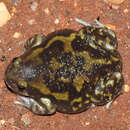en
names in breadcrumbs


Uperodon systoma és una espècie d'amfibi de la família dels microhílids. Es troba al sud, est i nord-oest de l'Índia, nord-est de Pakistan (a les Muntanyes Shakarparian), Nepal i nord i sud-est de Sri Lanka. És present des del nivell del mar fins als 1.000 metres. A Sri Lanka i a Gujarat (Índia) és comuna en el seu hàbitat preferent, mentre que a Pakistan és una espècie rara.[1]
Gran part del temps viu enterrada en sòls solts i humits. S'ha observat en boscos, planes, jardins particulars i en àrees amb agricultura poc intensa. Els adults surten a la superfície durant els monsons i es reprodueixen; els mascles canten des de les ribes de torrents o arrossars i els ous es dipositen en masses que suren a l'aigua. A Pakistan s'ha vist que els tèrmits són la principal font d'aliment de l'espècie.[1]
Uperodon systoma és una espècie d'amfibi de la família dels microhílids. Es troba al sud, est i nord-oest de l'Índia, nord-est de Pakistan (a les Muntanyes Shakarparian), Nepal i nord i sud-est de Sri Lanka. És present des del nivell del mar fins als 1.000 metres. A Sri Lanka i a Gujarat (Índia) és comuna en el seu hàbitat preferent, mentre que a Pakistan és una espècie rara.
Gran part del temps viu enterrada en sòls solts i humits. S'ha observat en boscos, planes, jardins particulars i en àrees amb agricultura poc intensa. Els adults surten a la superfície durant els monsons i es reprodueixen; els mascles canten des de les ribes de torrents o arrossars i els ous es dipositen en masses que suren a l'aigua. A Pakistan s'ha vist que els tèrmits són la principal font d'aliment de l'espècie.
Uperodon systoma is a species of narrow-mouthed frog found in Pakistan, India, Nepal, and Sri Lanka. It is known under many different common names: indistinct frog, marbled balloon frog, and lesser balloon frog.[2]
As the common names suggest, Uperodon systoma have a very stout appearance with a relatively small head. They grow up to 64 mm (2.5 in) in snout–vent length.[3]
Uperodon systoma lack teeth. This unusual feature is probably related to their diet that (after metamorphosis) consists mainly of termites and ants, with other insects appearing in smaller numbers. It is suggested that in capturing such small but spatially clustered prey items teeth would not be very useful; instead, the prey are gathered using their tongue.[4]
Uperodon systoma is a fossorial species that buries itself in soil. These frogs have been observed in a number of habitats, such as dry forests, plains, gardens, and agricultural areas. Adults are only seen during the summer monsoons; otherwise they retreat into the soil.[1] Feeding may be concentrated to rainy nights during the monsoon when termites emerge to swarm.[5]
Breeding takes place during the monsoon rains when the males call from the banks of streams and paddy fields. Eggs are laid in water where they float.[1]
Uperodon systoma is a species of narrow-mouthed frog found in Pakistan, India, Nepal, and Sri Lanka. It is known under many different common names: indistinct frog, marbled balloon frog, and lesser balloon frog.
Uperodon systoma es una especie de anfibio anuro de la familia Microhylidae. Se distribuye ampliamente por el sur de Asia: sur y este de la India, Nepal, noreste de Pakistán y norte y sureste de Sri Lanka. Su rango altitudinal va desde el nivel del mar hasta los 1000 metros. Es una especie completamente fosorial.
Uperodon systoma es una especie de anfibio anuro de la familia Microhylidae. Se distribuye ampliamente por el sur de Asia: sur y este de la India, Nepal, noreste de Pakistán y norte y sureste de Sri Lanka. Su rango altitudinal va desde el nivel del mar hasta los 1000 metros. Es una especie completamente fosorial.
Uperodon systoma Uperodon generoko animalia da. Anfibioen barruko Microhylidae familian sailkatuta dago, Anura ordenan.
Uperodon systoma Uperodon generoko animalia da. Anfibioen barruko Microhylidae familian sailkatuta dago, Anura ordenan.
Uperodon systoma est une espèce d'amphibiens de la famille des Microhylidae[1].
Cette espèce se rencontre en Inde, au Népal, au Pakistan et au Sri Lanka[1],[2].
Sa présence est incertaine au Bangladesh.
Uperodon systoma mesure environ 55 mm[3].
Les espèces Engystoma marmoratum[4] et Systoma leschenaultii[5] ont été placées en synonymie avec Uperodon systoma par Duméril et Bibron en 1841[6] et Pachybatrachus petersii[3] par Boulenger en 1882[7].
Uperodon systoma est une espèce d'amphibiens de la famille des Microhylidae.
Uperodon systoma is een kikkersoort uit het geslacht Uperodon in de familie van de smalbekkikkers (Microhylidae).[2]
De wetenschappelijke naam werd voor het eerst geldig gepubliceerd in 1799 door Johann Gottlob Schneider als Rana systoma.[3]
De kikker komt voor in delen van Azië en leeft in de landen Bangladesh, India, Pakistan en Sri Lanka.[4]